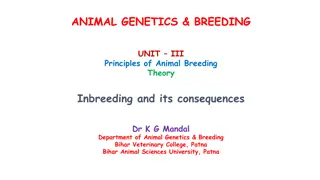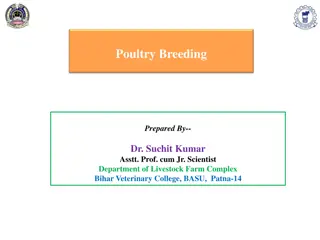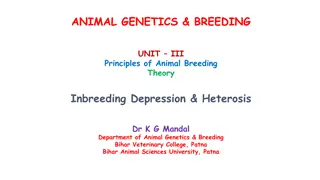Buy Doms Game Fowls online - bestgamefowls.com
Doms Game Fowls is the presence of a \u201cbarring\u201d gene. expresses barred or zig-zag spots of color caused by a. patterned inhibition (blocking) of color pigmentation. The color in the pattern may be inhibited to pure white. I do inbreeding and crossbreeding. I have a total of 260 doms. \nWhat
2 views • 2 slides
Understanding Inbreeding and Its Consequences in Animal Genetics & Breeding
Inbreeding in animal breeding involves mating closely related individuals, resulting in common ancestors within the preceding generations. This practice can have both positive and negative consequences on genetic diversity and health. Various types of inbreeding such as selfing, full-sib mating, and
0 views • 18 slides
Principles of Animal Breeding: Introduction and Historical Perspective
This unit covers the introduction to animal breeding, the application of genetics principles in breeding, historical perspectives including the work of Robert Bakewell, and key events in animal breeding evolution. Topics include breeding systems, importance of animal breeding, and notable figures in
1 views • 12 slides
Understanding Degree of Inbreeding in Animal Genetics and Breeding
Degree of inbreeding refers to the extent to which an individual carries genes identical by descent. This concept is crucial in animal breeding as it affects genetic diversity and homozygosity in offspring. The coefficient of inbreeding is used to measure the level of inbreeding, with higher values
1 views • 30 slides
Understanding Inbreeding in Animal Genetics & Breeding
Explore the principles of animal breeding theory focusing on inbreeding and its consequences, including examples like selfing, full-sib mating, and genetic effects. Learn about close breeding, line breeding, and genetic consequences of inbreeding in animal populations. Discover how inbreeding affect
0 views • 13 slides
Principles and Systems of Poultry Breeding: A Comprehensive Guide
Poultry breeding, led by experts like Dr. Suchit Kumar, involves purposeful selection and mating to improve size, weight, egg production, and meat quality. Environmental factors are crucial, and different breeding systems like inbreeding and line breeding play a role in genetic improvement. Continuo
1 views • 21 slides
Understanding Degree of Inbreeding and its Measurement in Animal Genetics and Breeding
Degree of inbreeding in animals is the extent to which genes are identical by descent within an individual. The coefficient of inbreeding, denoted by F, measures this degree and represents the increase in homozygosity in offspring from closely related matings. Two sources of homozygosity are genes a
0 views • 15 slides
Understanding Inbreeding Depression and Heterosis in Animal Genetics
Inbreeding depression is a decrease in the mean phenotypic value of traits related to fitness and physiological efficiency due to inbreeding. It involves a reduction in heterozygosity within a population, leading to an increase in homozygosity. The degree of inbreeding is quantified using the inbree
0 views • 24 slides
Insights from the War of Spanish Succession (1702-1713)
The War of Spanish Succession (1702-1713) marked Louis XIV's final war, reflecting a complex political landscape in Europe. The conflict arose due to the declining power of Spain, with the last Hapsburg monarch, Charles II, facing challenges of inbreeding and mental deficiencies. The struggle for co
0 views • 20 slides
Analysis of inbreeding and average relationship in Hungarian Hucul horse population
This study presented at the 27th Annual Meeting of Dagene in April 2016 focuses on the genetic structure of the Hungarian Hucul horse population based on pedigree data. The research analyzed inbreeding coefficients and average relatedness using the Endog software to understand the breeding strategie
0 views • 11 slides
Principles of Animal Breeding: An Introduction to Genetics and Breeding Methods
This content provides an overview of animal breeding, discussing its historical perspective, breeding systems/methodologies, and the application of genetics for genetic improvement in plants and animals. It covers key figures like Robert Bakewell and their contributions to the field, as well as the
0 views • 12 slides










